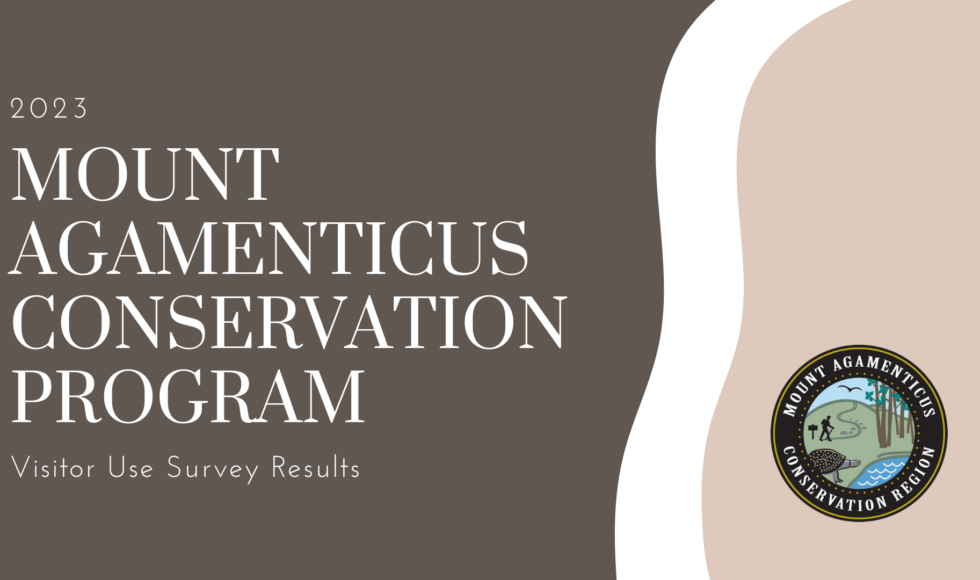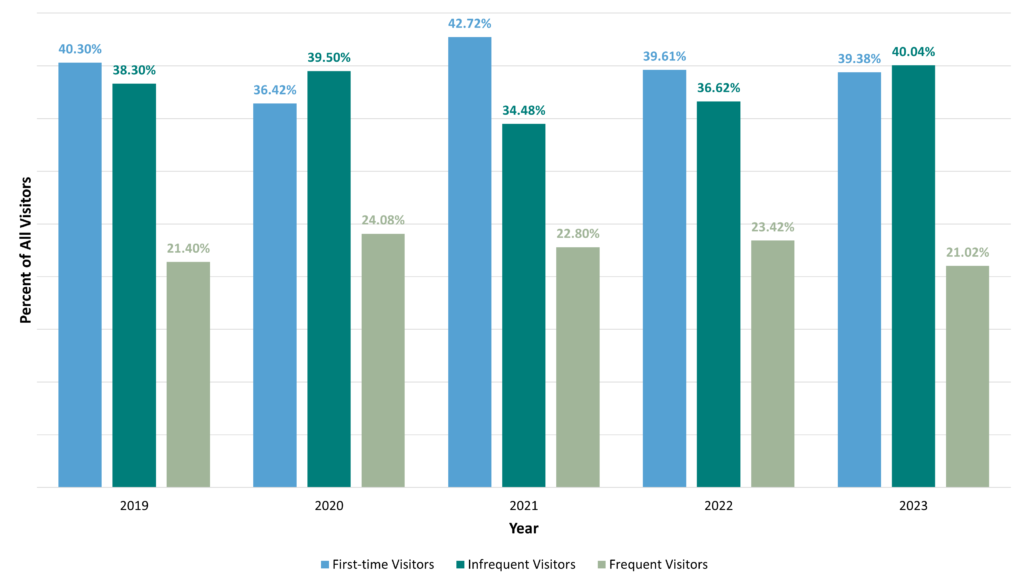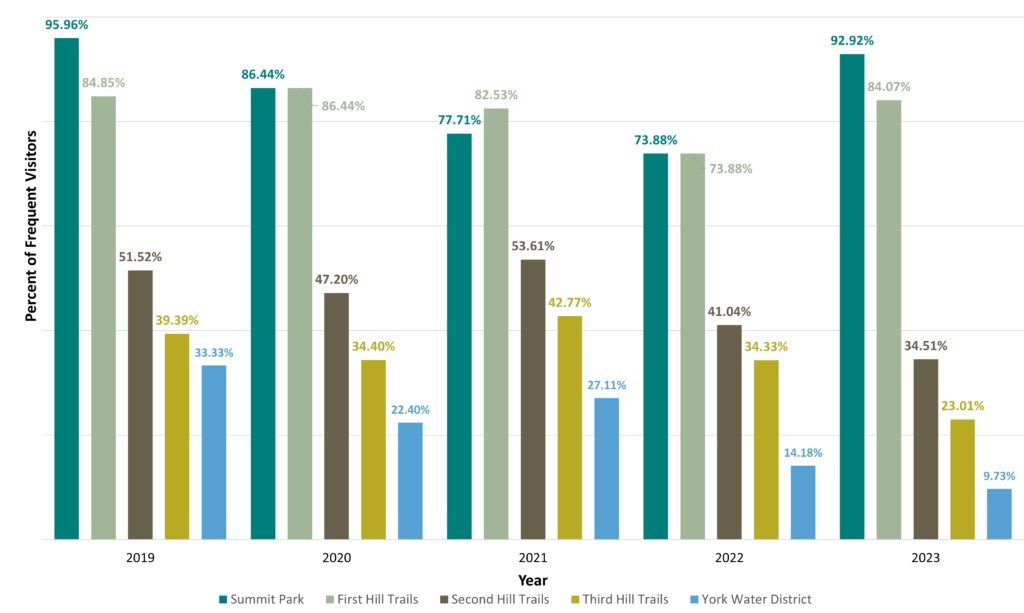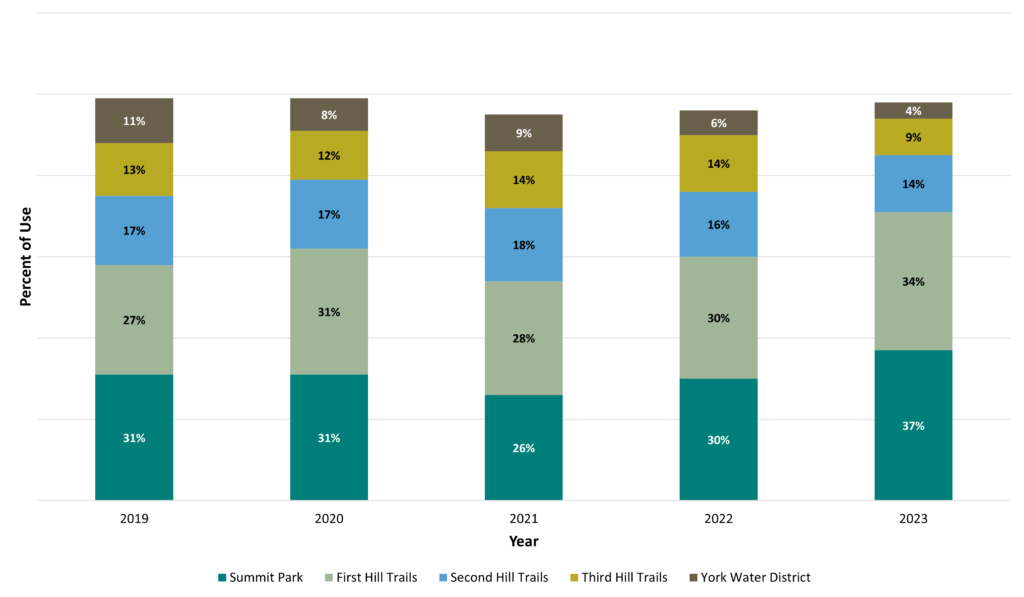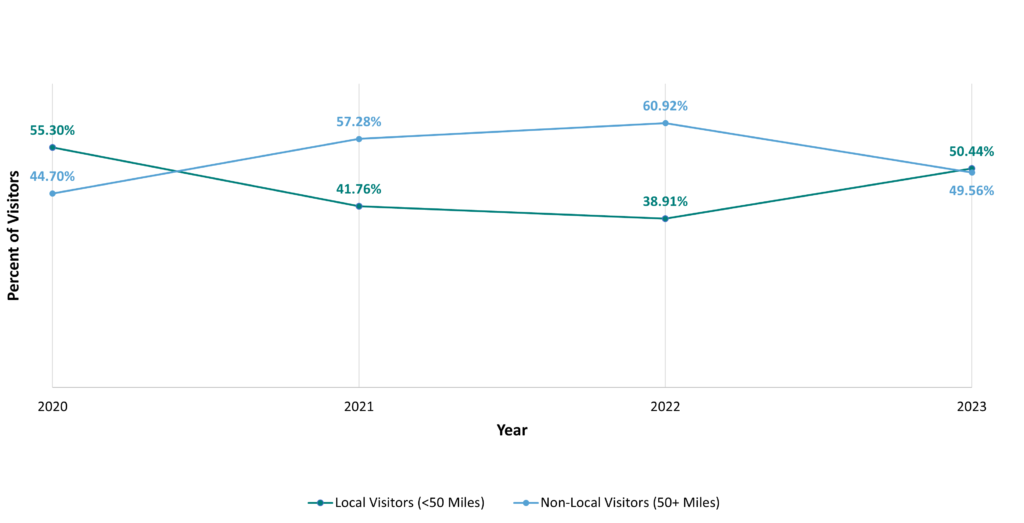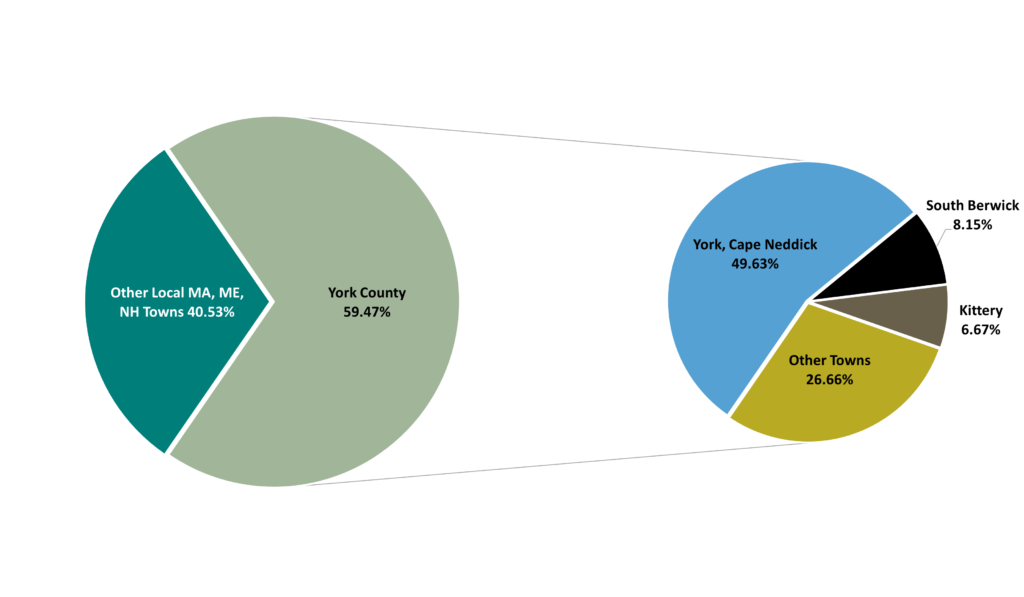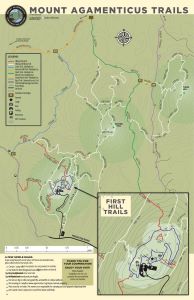The Mount Agamenticus Visitor Use survey is a tool that allows for the collection and analysis of data on who is visiting the mountain along with how the trails and surrounding lands are used. The survey also offers Conservation Program staff an opportunity to receive direct visitor feedback. Data is gathered annually to allow for the analysis of changing trends.
From three in-person survey sessions each day for seven days at the Base and Summit of First Hill, staff spoke with 1,074 visitors in 452 total surveys over the course of 84 total survey hours. There were fewer total surveys in 2023 than in previous years, but as always, the weather significantly impacts visitation. The survey period took place during the last week of July through the first two weeks of August. There was no online survey this year.
Highlights
Visit Frequency:
- 178 (39.38% of groups) first-time visitors and of those, 9.29% live locally (within 50 miles).
- 95 (21.02% of groups) frequent visitors (visiting monthly or more often).
- Of our frequent visitors, most (54.26%) visit at least once a month; 18.09% visit at least once a week; 27.46% visit more than once a week.
- 170 (40.04% of groups) infrequent visitors (those who visit a few times a year or are returning for the second or third time).
- It is typical that first-time visitors make up the bulk of those surveyed.
- It is also typical to see more infrequent than frequent visitors during our survey period.
First-Time Visitors:
- 45% of first-time visitors heard of Mount A through friends or family.
- 15% of first-time visitors found Mount A with a web search or through a website or app (including AllTrails, Strava, and TrailForks).
- A mobile-ready Agamenticus.org remains a priority for providing all visitors with accurate, timely and easily accessible information.
- As the reliance on crowdsourced apps and websites continues to increase, it’s important that outreach efforts include regularly checking these sources for accuracy.

Tracking the trend of internet and app use to discover Mount Agamenticus among first-time visitors from 2019-2023
- 96% of first-time visitors heard of Mount A through “word of mouth,” from local businesses or other means, and a very small percentage (3.37%) found out about Mount A from street signs, maps, or information available at local welcome and information centers.
Frequent Visitors:
- Seasons: 81% of frequent visitors surveyed visit the mountain all year round. This is a 3.20% increase over LY.
- 23% visit in spring, summer, and fall.
- A few visitors (9.57%) visit only in the summer.
- Roughly 7% more people visit in summer and fall only, versus those who visit only in the spring and summer.
- Areas: The most frequented areas are the summit park and First Hill (just over 92% and 84% of frequent visitors, respectively, significant increases over LY). Reported use of Second Hill decreased by 6.53% and use of Third Hill decreased by 11.32% from LY. The graphs below do not show reported use of unmarked/unmanaged trails.
- Favorite Trails: Ring Trail is the favorite of 42.92% of frequent visitors. The next favorite is the Big A (18.37%), followed by Blueberry Bluff (16.33%).
- 65% of frequent visitors named at least one trail on First Hill, 8.16% on Second Hill, and only one visitor named a Third Hill trail as their favorite.
- 47% of frequent visitors listed more than one trail, and a handful of those visitors named specific trails for specific recreational uses!
- 06% of frequent visitors named neighboring York Water District trails as their favorite trails (9.73% of frequent visitors utilize those trails).
- Trail Feedback: 78.95% of frequent visitors, 84 people, had no critical feedback about the trails. Six people (6.32%) recognized standing water and drainages as an issue, and another two people mentioned erosion as an “other,” but related concern.
Activities:
- Most people come to Mount A to hike or sightsee:
- Hiking, 72.57% of groups surveyed (1.77% increase over LY), 16.81% of all responses.
- Sightseeing, 66.37% of groups surveyed (10.26% increase), 15.38% of all responses.
- Walking, 21.68% of groups surveyed (7.52% decrease from LY).
- Dog Walking, 14.60% of groups surveyed.
- Running, 5.53% of groups surveyed.
- Birding, 3.32% of groups surveyed.
- Mountain Biking, 7.30% of groups surveyed.
- Winter recreational activities, 2.88% of groups surveyed.
- 79% of frequent visitors (15% of all responses) visit the mountain during the winter, a 10.68% increase over LY. Winter visitation seems to be on an upward trend, while reported winter-specific activities (skiing and snowshoeing) have decreased over time.
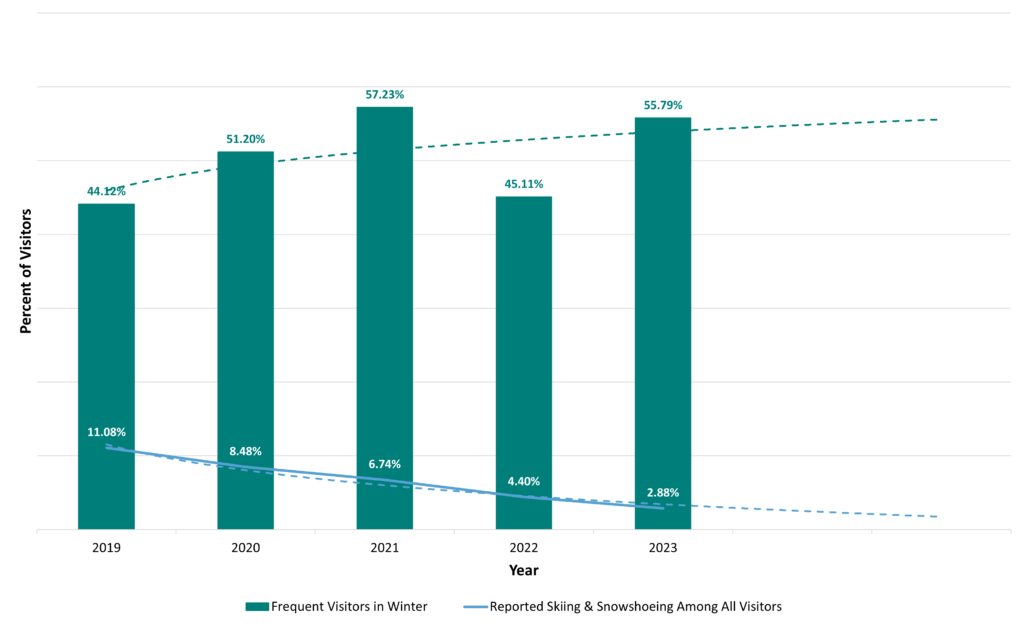
Comparison of winter visitation among frequent visitors to reported winter-specific activities from 2019-2023
Where Visitors Are From:
- 49.56% of visitors to Mount A are from 50+ miles away, a decrease of 11.36% from LY
-
- Of non-local visitors, most were from MA (27.35%; 13.56% of all visitors).
- 98% (of all visitors) from NH, 4% from CT, 3.11% from NY.
- 16 international visitors, visiting the area from Austria, Canada, Germany, Ireland, the Philippines, United Arab Emirates, and the UK.
- People traveling from Canada made up 2% of all visitors.
- 44% are local, living within 50 miles of Mount A.
- 63% of local visitors are from ME, 31.78% of all visitors; 14.54% are from NH, and 2.20% are from MA.
- 47% of local visitors live in York County.
- 29.51% of all local visitors are from York or Cape Neddick.
- 47% of local visitors live in York County.
- 63% of local visitors are from ME, 31.78% of all visitors; 14.54% are from NH, and 2.20% are from MA.
Day Trips and Overnight Visitors:
- 56% in the area on overnight or extended trips, a 15.59% decrease from LY.
- Of overnight visitors, 41.88% were staying in York or Cape Neddick; 20.63% staying in Wells; 16.88% staying in Ogunquit.
- While most of these visitors are staying overnight locally, there are also many who stay further away (as far away as Boothbay, ME) and include Mount A in their day trip to York and the surrounding area.
- 67% here for a day trip, an increase of 10.66% over LY.
- 78% of day trippers were non-local, traveling to the area from over 50 miles away.
What Visitors Enjoy Most:
- Individual responses are sorted into broader categories and then counted. Many visitors had difficulty choosing only one thing about Mount A that they enjoyed most! Anecdotally, infrequent visitors had the greatest number of responses this year, with 247 total responses in only 181 surveys.
- Over the years, “the view” is by far the most typical response to this question. This year, 38% of all visitors surveyed provided this response. 45.40% of first-time visitors, 41.70% of infrequent visitors, and 26.32% of frequent visitors most enjoyed the view.
- Other notable category responses:
- Trails (general, terrain, condition), 9.07% of all; 10.92% of first-time; 9.31% of infrequent; 6.02% of frequent visitors
- Quiet, 8.17% of all; 2.87% of first-time; 7.69% of infrequent; 15.79% of frequent visitors
- Nature, 7.44% of all; 6.90% of first-time; 4.86% of infrequent; 12.78% of frequent visitors
- Summit park facilities and amenities (including parking and restrooms), 7.26% of all; 7.47% of first-time; 8.10% of infrequent; 6.02% of frequent visitors
- Recreation (specific mention of recreational activity or opportunity), 6.17% of all; 5.17% of first-time; 6.88% of infrequent; 6.02% of frequent visitors
- Accessibility (ease, access, variety), 4.36% of all; 4.02% of first-time; 4.05% of infrequent; 5.26% of frequent visitors
Comments and Suggestions:
These yearly survey sessions provide an opportunity for the Conservation Program to receive additional comments and suggestions directly from visitors, as well as answer questions and address any concerns. This year, many visitors had feedback about the parking and restroom upgrades and the new seasonal Admission Fee. Most people appreciated the improvements, or at least recognized the need. However, the app-only method of fee collection was confusing, complicated, or inaccessible for many. The feedback received during the survey period, along with other seasonal data, helped inform the Conservation Program’s recommendations to the Town of York Selectboard regarding changes to fee collection methods and fee structure moving into the 2024 season.
Conclusion:
Every season presents its own set of challenges, and this year was certainly no different, as our facilities underwent a massive change in just a few months. The Visitor Use Survey is only a snapshot of our estimated 50,000 plus yearly visitors. Mount Agamenticus is frequented not only by seasonal visitors to the seacoast, but by local residents who come as often as they can. We are always surprised by the number of people who are finding their way to the mountain for the first time, but we hope that they will return, like so many others, for many years to come. We will continue our efforts to provide all-important recreational access to the outdoors while maintaining a delicate balance with habitat and water quality. Despite the challenges and changes that 2023 brought with it, the support from the surrounding community did not go unnoticed. The Conservation Program looks forward to an exciting field season in 2024. Thank you for making Mount Agamenticus part of your outdoor experience.
If you have questions, comments, or feedback about the Visitor Use Survey, please contact the Mount Agamenticus Conservation Program Outreach and Education Coordinator.
This report can also be downloaded as a printable PDF file (link opens in new tab).
For a stewardship update and field season highlights, please see 2023 Stewardship Report.
For outreach and environmental education highlights, please see the 2023 Outreach and Education Report.
Last modified: April 3, 2024
